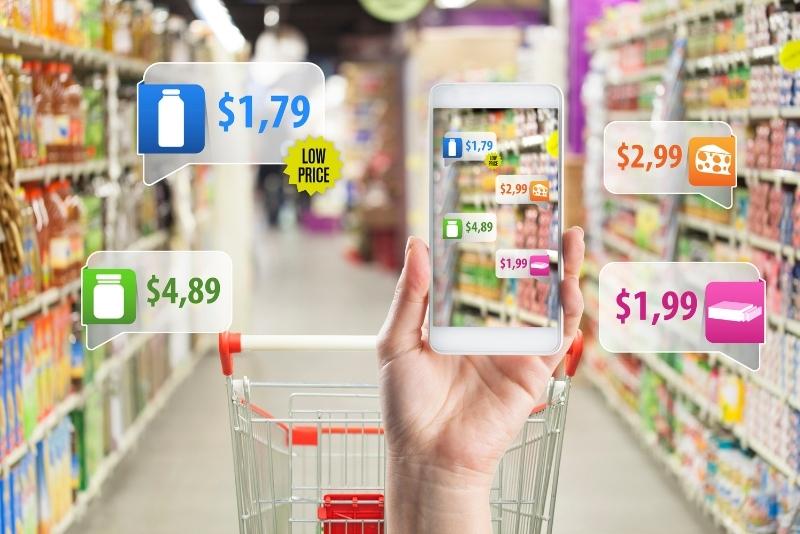Retail is a highly competitive sector where every business tries to get new customers and hold the existing ones. Thanks to the rising technology and increase of communication channels, retailers can find newer and better ways to attract customers. One of these ways is Augmented Reality (AR), and it is getting more and more popular each day. It is a relatively new technology and definitely beyond what we are used to. Although it is already an attractive way used in retail marketing. Retailers use AR to give their customers better shopping experiences and help them in their buying decisions. This is done by better, more intimate, and in-depth viewing of products.
HOW CAN WE USE AR IN RETAIL?
With the evolution of Augmented and Virtual Reality (VR) and the 5G mobile networks, user experience is also evolving, and the expectations are getting higher. Examples like Snapchat or Pokémon Go going viral show us how trending technologies can deeply change our daily lives. Retailers are aware of this impact and adopted AR into their businesses to make marketing more effective. This helps to replace the usage of traditional billboards or sharing online photos and videos. This contemporary approach provides a unique and more memorable experience to their customers hence increasing their willingness
to buy.
In retail, AR acts as a bridge between the online and offline world. Also, allows users to be more interactive in their buying process. It links the consumers and brands in an innovative and enriched way. Retailers can benefit from this experience not only by the marketing in their physical shops. Also, benefit from their online presence since consumers can easily engage with AR-based retail from mobile devices. AR is an easy, fun, and helpful technology that can be used without any special equipment or training. Moreover, it offers shoppers a better buying experience and greater satisfaction. Here is a few examples of the use of AR in the retail industry.

APPAREL, ACCESSORIES, AND SHOES
Apparel is one of the most extensive sectors of the retail industry. From the high-end customers to the low-end, there is a wide selection of people who shop for clothes. Some of the businesses in this sector use AR to lead this big group of prospects. A very simple yet attractive way they use AR is to turn their displaying window into a virtual mirror. This lets customers try on different clothes and accessories without undressing and even entering the shops. Like clothing or shoe, companies are also adopting AR. This is done in order to enable their customers to try out different designs, colors, and sizes digitally.
AR FOR GROCERY AND HOME GOODS RETAIL
In large retail stores, especially in supermarkets where people often lose their directions, using AR can be an efficient solution. By using AR-based maps in these large-scale shops or malls, shoppers can find their ways easily without feeling lost. Some stores offer more than just maps and add extra features to their AR apps. This lets you see if the product you are looking for has a discount or promotion, and compare the goods.
AR FOR FURNITURE AND DECORATION RETAIL
Large-scale furniture companies were one of the first to adopt AR in their marketing. They started with apps for scanning their catalogs to see more information about the products. Now through apps, you can put a digital copy of any furniture you want to buy for your house. Also, see if it fits properly or if it goes well with the color of your walls. And if you decide to change the color of your walls, there is even an app for that. Some color companies offer AR app solutions where you can hold your phone towards your wall and see different color options before even buying them.
AUTOMOTIVE AND ELECTRONICS
The automotive sector is using AR to let customers try out the cars and new features before deciding on the model and enhance the buying experiences. Retailers can take advantage of limitless digital inventory without worrying about the stock they have at the time. With one swipe on their phone screens, different color schemes appear onto the cars and give customers more choices while providing retailers more space and reducing the costs.
MAKEUP, JEWELRY AND BEAUTY INDUSTRY
We can understand how big the makeup sector is by looking at view counts on YouTube videos. To meet the needs of their customers, makeup companies have to find more effective ways for marketing. AR is one of the most effective and entertaining ways to try on makeup. This is important because sometimes it just does not look good as it looks on the model. AR apps let the customers try products virtually and read reviews. Also, see related items, and even show them off or get reviews by taking photos and sharing them.
WHY SHOULD WE USE AR IN RETAIL?
According to statistics, using AR in retail is highly practical and profitable. It gives customers more opportunities in the process of buying, such as more in-depth information, easier ways to try on, and more entertaining experiences. Trying and testing out products is easier because the digital copies replace the real, physical ones, and it cuts down the time and effort spent. Allowing shoppers to make better decisions and have a smoother buying process in this way increases user satisfaction and decreases return rates.
By using AR-based apps in retail, shoppers can benefit both from the online and offline world of shopping. They can shop online easily from their smartphones but have offline shop characteristics like trying on and viewing the real size of a product. Undoubtedly AR is a beneficial technology both for sellers and buyers in retail, and we will see a lot more of it in this highly competitive, user experience based industry



